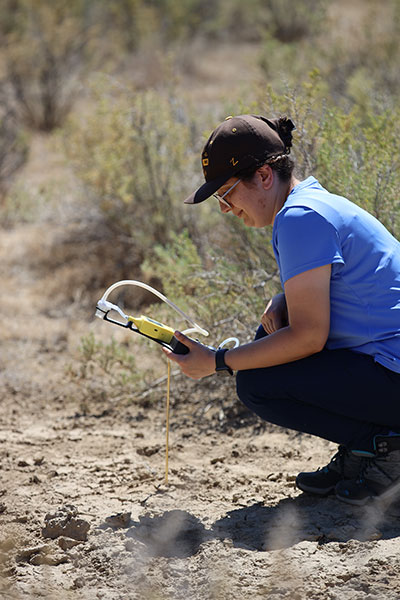UW’s SER Runs Field Course to Advance Geologic Hydrogen Project in Wyoming
Published August 29, 2025

UW Ph.D. student Sheida Sheikheh, in the Department of Energy and Petroleum Engineering, takes a measurement in the field as part of the Wyoming Geohydrogen Exploration Project. (Sarah Buckhold Photo)
The University of Wyoming School of Energy Resources (SER) hosted an immersive field course for industry partners and UW students as part of a geologic hydrogen project in Wyoming.
Identified by the U.S. Geological Survey as a geologic hydrogen prospect, Wyoming has meaningful potential for naturally occurring, or geologic, hydrogen. This creates an opportunity to develop a new, abundant, low-cost energy resource by leveraging the state’s existing strengths in the fossil fuel and mining industries.
Funded through private investment from Hestia Energy Corp. and matched through a state of Wyoming artificial intelligence (AI) state matching appropriation, the Wyoming Geohydrogen Exploration Project seeks to assess the occurrence of geologic hydrogen in Wyoming, using advanced AI and machine learning technology for precision modeling and mapping resources.
Leading the project as principal investigator (PI) is Sarah Buckhold, an assistant research professional in SER’s Hydrogen Energy Research Center (H2ERC), along with H2ERC Senior Research Professional Charles Nye, serving as co-PI.
“Currently, there's very little known about the full extent of geologic hydrogen deposits,” Buckhold says. “This is a relatively new area of investigation, and a lot of the work involves fundamental research to locate and characterize these deposits. AI and machine learning techniques developed for the oil and gas industry could be a game-changer for geologic hydrogen exploration, and the cross-application of technology could significantly accelerate the discovery and assessment of geologic hydrogen resources, potentially shortening the timeline from exploration to commercial viability.”
Early stages of the project involved inputting currently known data -- such as geologic records, well logs and gas analyses -- into an AI/machine learning model to locate high-confidence areas of prospective geologic hydrogen.
Subsequent work on the project requires collecting samples from those areas identified in the model and feeding the results back into the model in an iterative loop.
Seizing the opportunity to pair hands-on learning with the research, the team opened a volunteer field course opportunity to UW students over the course of a week in August. The team, along with UW students Sheida Sheikheh, Himadri Das, Trang Nguyen and Frederick Gyaase, in the Department of Energy and Petroleum Engineering; Farshad Ghorbanishovaneh, in the Department of Computer Science; Prince Duah, in the Department of Chemical and Biomedical Engineering; Chakradhar Bhoopalli, in the Department of Electrical Engineering; and Therese Turner, in the Department of Wildlife and Fisheries Biology and Management, traveled to multiple locations in Wyoming to collect water and mineral samples, determining the presence of geologic hydrogen.
“Involving students in our innovative research supports the university’s educational mission, in addition to the research and outreach missions, which our scientists routinely serve,” Nye says. “There is a level of uncertainty on the cutting edge because we don’t know the result of our experiments and studies beforehand -- but that’s how science advances. Students deserve to see our surprise when new and unexpected data comes in, and our struggle to explain what we see, because that is when critical thinking kicks into high gear.”
By leveraging a newly updated model and recently collected data, the team aims to significantly enhance AI/machine learning development at UW. UW’s AI/machine learning expertise is expected to hint at new interpretations and explanations. The next step will be to identify new areas for testing and sampling.
“Advancing this resource could help diversify Wyoming’s energy economy and position the state at the forefront of a market that is projected to expand in the coming years,” says H2ERC Director Eugene Holybnyak. “Early investment in this area is critical to determine if it’s economically viable to recover and utilize the hydrogen. This involves not only finding the hydrogen but also understanding the geological systems that produce and trap it. This project will result in a better understanding of the occurrence of geologic hydrogen in Wyoming, as well as establishing expertise at UW in AI and machine learning.”

